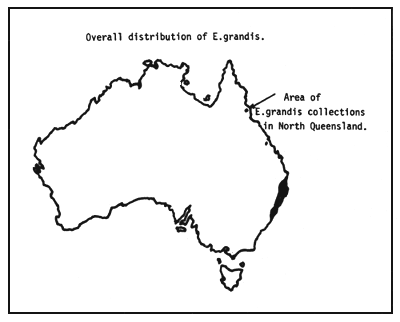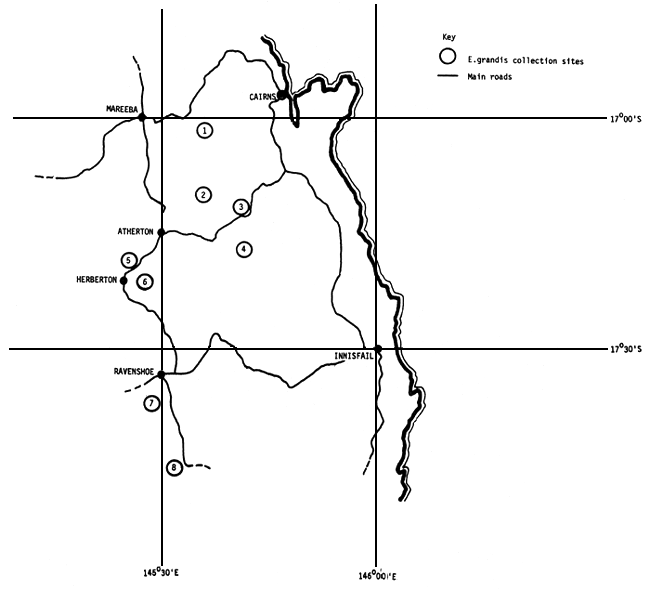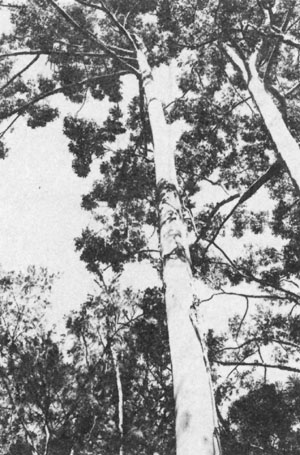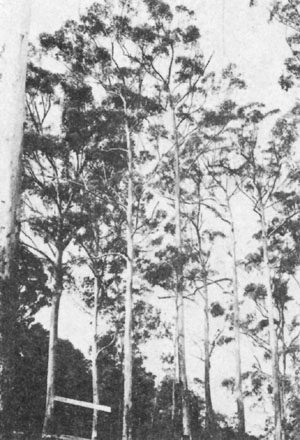by
J.C. Doran
CSIRO Division of Forest Research
P.O. Box 4008
Canberra, A.C.T. 2600
Australia
INTRODUCTION
Eucalyptus grandis is a tall tree (up to 40–60 m) of the moist flats and lower slopes of the coastal regions of north-eastern New South Wales and south-eastern Queensland. Further north, disjunct populations occur near Mackay and on the Atherton Tablelands of north Queensland.
In the Atherton region, E. grandis occurs in small discontinuous stands on the deep, red volcanic soils of the river flats and slopes on the fringes of rainforest. Typically it is found as pure or almost pure stands; but occasionally it occurs in association with E. cloeziana, E. resinifera, E. pellita, E. intermedia, Casuarina torulosa and other species. The altitudinal range of E. grandis on the Tablelands is about 600 to 1 100 m. This part of the distribution is in the warm-humid climatic zone, and the meteorological station at Atherton provides representative temperature and rainfall figures (Table 1).
E. grandis is a major plantation species overseas, where on suitable sites it combines rapid height growth with good stem form and wood qualities. Of importance also is its ability to coppice vigorously from the stump after harvesting.
In the humid to sub-humid, tropical to sub-tropical zones of Brazil, E. grandis is planted extensively for the production of pulpwood, charcoal and other end uses. Early plantations were established using seed from southern Australian sources which, in the wetter areas, have proved to be highly susceptible to attack by the stem canker fungus, Diaporthe cubensis. Trials in Brazil have shown that E. grandis provenances from the Atherton region are superior to southern sources in their resistance to the disease. The Atherton provenance is now the only seed source of E. grandis recommended for use in areas affected by the canker disease, and the current demand for seed is high.
Because of the increasing demand for seed from Brazil, and with the thought that similar problems might arise in other tropical countries, seed collections of E. grandis were carried out by officers of the CSIRO Division of Forest Research on the Atherton Tableland during November 1977.
SEED COLLECTIONS
From the 7 to 19 November 1977 a two-man field party from Canberra travelled to north Queensland and undertook seed collections of E. grandis in the Ravenshoe area. The costs of the trip were met, in part, using funds from the Food and Agriculture Organization's grant to the CSIRO Division of Forest Research for collection of forest tree seed.
Twenty-six trees of average to above average form and no less than 30 m apart were selected and mapped, and sampled using a .308 calibre rifle with soft nose bullets to cut-off seed bearing limbs. The seed obtained was kept separate by individual trees and totalled some 3.5 kg. Details of the Ravenshoe collections are given in Figure 1 and Table 2.
While the CSIRO party was working in north Queensland, contact was made with two private groups who were collecting E. grandis seed on behalf of Brazilian forest companies. It was possible to purchase and exchange seed with these groups, therefore, extending the range of available provenances. Details of the more important of these collections are included in Figure 1 and Table 2.
Photographs of trees in two stands, collection sites 7 and 8, are given in Figures 2 and 3, where the typical tall, shaft-like form of this species is clearly illustrated.
AVAILABILITY OF SEED
Samples of seed of all E. grandis provenances described in this paper are available for exchange or purchase from:
Officer-in-Charge
Seed Section
CSIRO Division of Forest Research
P.O. Box 4008
Canberra, A.C.T. 2600
Australia
ACKNOWLEDGEMENTS
The author wishes to acknowledge the technical assistance of Messrs. D. Kleinig, M. Connell and J. Burns in making the collections. Mr. D. Kleinig provided the photographs and the maps were produced by Mrs. M. Risby. Thanks are offered also to Mr. E. Campinhos Jr of Aracruz Florestal S.A., Brazil who cooperated in the seed exchange.
Table 1. Monthly temperature and rainfall data from the Atherton meteorological station (17°17'S, 145°27'E, altitude 752 m)
| Jan | Feb | Mar | Apr | May | June | July | Aug | Sept | Oct | Nov | Dec | Mean | |
| Mean daily max. temperature (°C) | 29 | 28 | 27 | 25 | 23 | 22 | 22 | 23 | 25 | 27 | 29 | 30 | 26 |
| Mean daily min. temperature (°C) | 18 | 18 | 17 | 15 | 13 | 11 | 10 | 10 | 12 | 13 | 16 | 17 | 14 |
| Average monthly rainfall (mm) | 284 | 305 | 241 | 109 | 60 | 42 | 30 | 20 | 20 | 24 | 70 | 167 | 1372 (Total) |
| Average number of frosts per year = 1.4 | |||||||||||||
| Lowest temperatures on record = -2.5°C | |||||||||||||
Table 2. Summary of provenance data - 1977 E. grandis collections in north Queensland
| Collection site number | Provenance location | Latitude °S | Longitude °E | Altitude (m) | Details of trees within provenance | Weight of seed available (gm) | Average seed viability per 10 g | ||
| Number of trees sampled | Range of heights (m) | Range of diam breast height (cm) | |||||||
| 1 | East of Mareeba | 17°03' | 145°36' | 740 | 7 | 23–33 | 33– 46 | 500 | 5200 |
| 2 | Tinaroo Falls Dam area | 17°11' | 145°36' | 800 | 13 | 30–48 | 30–120 | 65 | 4800 |
| 3 | S.F.R. 700 Gillies Highway | 17°13' | 145°42' | 730 | 10 | 33–49 | 51–170 | 77 | 5300 |
| 4 | S.F.R. 310 Gadgarra | 17°15'–17°17' | 145°42' | 680–700 | 20 | 28–65 | 33–190 | 111 | 5600 |
| 5 | Herberton area | 17°20'–17°21' | 145°24'–145°25' | 900–1100 | 6 | 20–37 | 46– 89 | 500 | 4400 |
| 6 | Wondecla area | 17°23'–17°27' | 145°27'–145°28' | 980–1040 | 13 | 9–32 | 15–100 | 500 | 6400 |
| 7 | Ravenshoe area | 17°42' | 145°28' | 940 | 26 | 26–56 | 53–200 | 3509 | 4700 |
| 8 | Tully Falls area | 17°49' | 145°31' | 800 | 6 | 33–38 | 76– 96 | 500 | 7700 |
 |  |

Figure 1. Eucalyptus grandis, natural distribution and seed collection sites in the Atherton area of north Queensland

Figure 2. A Eucalyptus grandis seed tree at site 7. The photograph illustrates the typical, tall, ‘shaft-like’ form of this species

Figure 3. A group of Eucalyptus grandis trees at site 8